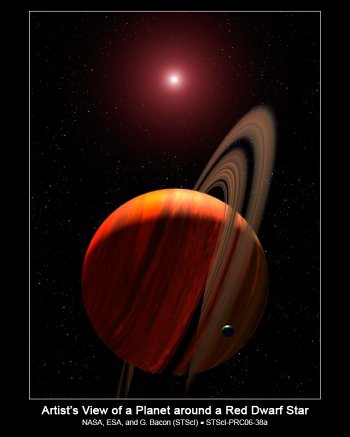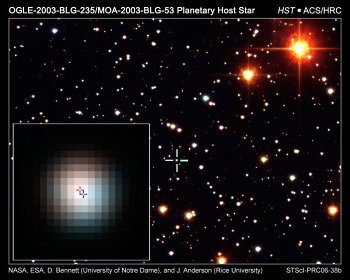NASA’s Hubble Space Telescope continues to surprise astronomers, this time by identifying the parent star of a distant planet through the observational technique of gravitational microlensing. By elucidating detailed information about the star associated with an exoplanet, astronomers should now be able to unearth the properties of the planet itself and so improve our understanding of planet formation and evolution.
Microlensing occurs when a foreground star or other body amplifies the light of a background star when the two are momentarily in alignment. The technique exploits the random motions of stars, which are generally too small to be noticed without precise measurements. If one star passes in front of another the gravity of the foreground star acts like a giant lens, magnifying the light from the background star. The particular way in which the path of the light from the background star is affected can reveal clues about the physical characteristics of the foreground object. The new observations made by Hubble team member David Bennett of the University of Notre Dame, Indiana, and colleagues, provide conclusive information about the foreground star being observed and so will allow the properties of its accompanying planet to be made with greater certainty.

Artist’s impression of a gas giant orbiting a red dwarf star (Credit: NASA, ESA, and G. Bacon (STScI))
Hubble’s keen eye is perfectly suited for identifying a parent, or host star in our galaxy through microlensing, says Bennett. The identification of the host star is critical for a complete understanding of the planets discovered by microlensing, he adds.
The newly discovered host star goes by the esoteric name of OGLE-2003-BLG-235L/MOA-2003-BLG-53L. Its planetary companion was discovered in 2003 through ground-based gravitational microlensing observations, which reveals objects far too dim to be seen through conventional observations. The duration of the microlensing event is several months, and the extra brightening due to a planet lasts a few hours to a couple of days. The ground-based microlensing data had indicated a combined system of foreground and background stars plus a planet.

Hubble’s view of the host star’s neighbourhood (Credit: NASA, ESA, D. Bennett (University of Notre Dame) and J. Anderson (Rice University))
It was Hubble’s acuity that allowed the team to distinguish the light from the foreground and background star by making follow-up observations two years after the microlensing event. They could separate out the background source star from its neighbours in the very crowded star field in the direction of the centre of our galaxy and found it to be about 20 percent brighter than expected. This additional brightness is most likely from the foreground lens star, which hosts the planet.
Although the Hubble images were taken nearly two years after the lensing event, the source and lens stars were still so close together in the sky that they essentially appeared as one star. The Hubble observations were precise enough to discern the slight offset in the positions of the two stars. Observations over the next few years will reveal how the offset increases.
The newly discovered host star is more massive, and therefore hotter, than expected for a random field star in our galaxy at 63% the mass of our Sun compared with the average star’s 30% Solar mass. The measurements set its distance from Earth at 19,000 light-years and indicate that the planet is more than two and a half times as massive as the planet Jupiter.
A clearer understanding of host stars and their planetary guests will help astronomers validate our models of planet formation. One theory – the popular core-accretion model – predicts that giant planets grow from small rocky seeds in the debris around a star. The bigger the star, the bigger the disk, which means a greater chance of any planet formation resulting in a gas giant resembling Jupiter. The Hubble observations are consistent with this model.
Further reading
David Bennett
http://physics.nd.edu/Faculty/bennett.html
Suggested searches
gravitational lensing
extrasolar planets
planet formation